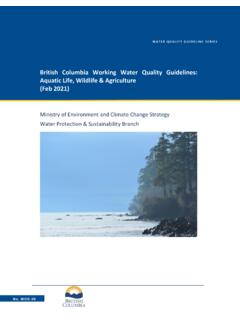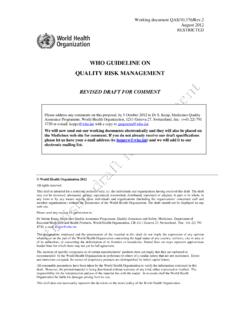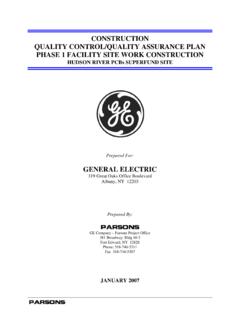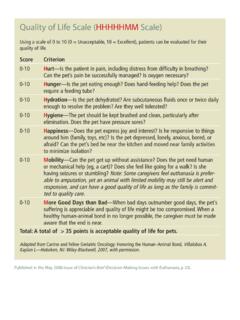Transcription of APPLICATION OF TOTAL QUALITY MANAGEMENT IN …
1 Journal of QUALITY and Technology MANAGEMENT Volume III, Issue I1, Dec 2007, pg 87-97. APPLICATION OF TOTAL QUALITY MANAGEMENT IN. EDUCATION. Farooq, M. S. Akhtar, Ullah Institute of Education and Research, University of the Punjab,Lahore. Memon Department of English, University of Sindh, Jamshoro Abstract The purpose of the paper is to analyzing thoughts of the modern MANAGEMENT paradigm TOTAL QUALITY MANAGEMENT (TQM), and its APPLICATION in the field of education. The basic theme of TQM is participatory approach to address the question(s) of QUALITY in business aswell as in the field of education. Reviewing fresh literature from the internet and other sources, the works of W. Edward Deming's: fourteen principles for QUALITY assurance, Philip Crosby's: fourteen points for QUALITY MANAGEMENT & the idea of zero defect, and J. Juran's three areas: QUALITY planning, QUALITY improvement and QUALITY control are discussed. INTRODUCTION organization, and focusing on long range profitability through customers'.
2 People want to do their best and it is the contentment, including benefits to MANAGEMENT 's job to provide society. It is the integration of all environment through continuous functions and processes within an improvement of the system, is the organization in order to achieve assumption, at which TOTAL QUALITY continuous improvement of the QUALITY MANAGEMENT is based. TOTAL QUALITY of good services (Akhtar, 2000;. MANAGEMENT (TQM) is an art of Besterfield, Michna, Besterfield &. organizing the whole to achieve Sarce, 2004; Fitzgerald, 2004). TQM has excellence. It is enrichment to the a strong impact on the values, culture, conventional way of managing business. and mind-sets within an organization by It helps for survival in the global providing technological modifications antagonism. This is not only a (Boje & Winsor 2005). philosophy but also a set of guide lines and regulations for ongoing The history of QUALITY control is improvements for the services and/or undoubtedly as old as industry itself.
3 Products offered to customers. Human TOTAL QUALITY movement was started resources and QUALITY methods are after the 2nd world war in industry, but utilized to improve all the processes to on large scale it attracted attention in satisfy all the needs of the clients. It 1980s, when Japanese captured a large integrates fundamental techniques, share of world market under the slogan prevailing efforts and practical gear, Made in Japan (Akhtar, 2000;. which are being operated under a Besterfield, Michna, Besterfield &. disciplined approach of MANAGEMENT . Sarce, 2004). After wards this concept This organizational MANAGEMENT move is shifted into other fields of life to paying attention towards QUALITY , which improve the performance by QUALITY is due to the collaboration of members of MANAGEMENT . Later on this movement 1. Journal of QUALITY and Technology MANAGEMENT Volume III, Issue I1, Dec 2007, pg 87-97. entered into the field of education to key person in TQM movement, in this have improvements in all walks of regard, thinks that inspection with the education.
4 Aim of finding the bad ones and throwing them out is ineffective and QUALITY is the entirety of facial costly. QUALITY is only the end product of appearance and distinctiveness of mass assessment but also from creation or service that bears a capability development of the procedure. He to congregate an acknowledged or (1991) states that MANAGEMENT 's role is implied want (Arnold & Holler, 1996; to asses origin of the problems; the Ross & Joel, 1999). According to Juran system or the people's activities. He (1988) it is fitness for use and according opined that it is the managers, not to Crosby (1979) it is conformance to workers who are responsible for 85% of requirement. The concept of QUALITY the defects in products or service. according to Sallis (1997) is usually According to Deming (1991), 85%. considered in two ways: Procedural performance of workers is assessed concept of QUALITY and Transformational through the system in which they work concept of QUALITY .
5 Procedural concept is and 15 % is determined by short of concerned with measuring up and skills. Workers aren't bad but the system ensuring conformity to a predetermined is not perfect. Deming says that people specification. The question that is asked work in the system and MANAGEMENT is does this good or service do what is creates the system. As a pioneer of TQM. asked or expected from it? This is fitness movement Deming has contributed for purpose. Transformational concept of several works: Fourteen points, the QUALITY views QUALITY as a complex system of profound knowledge, PDCA. process with a wider canvas. It focuses Cycle, Seven Deadly diseases. This on the softer and more intangible aspects paper presents summary of the Deming's of QUALITY . It has less to do with systems fourteen points in the next pages: and procedures and more to do with continuous improvement and 1. Generate Reliability of Function for organizational transformation. These Perfection of Merchandise and Service softer concepts are care, services and social assistance being provided.
6 This Develop a system for the up gradation type of QUALITY can be achieved through and betterment of the teaching learning exercise of leadership, which establishes processes. The focus should be on the a vision that translates into clientage intention that product of the system services. This approach is about would be valuable and be capable to improving the system. It is about doing participate and fulfill the societal needs things right, not just doing the right and desires in a purposeful manner. things. This concept of QUALITY aims for Organizations must develop a long-term excellence and is satisfied with fitness view and program to sustain in the field for purpose. Excellence is an aspiration for a range of goals and objectives. and striving for the best. Novelty is created and measures are adopted to guarantee the sustainability of Mass inspection is one of the wares and services for long term. organizational important strategies in Traditional models of MANAGEMENT focus achieving the targets.
7 Deming (1991) a only in defining the purpose of the 2. Journal of QUALITY and Technology MANAGEMENT Volume III, Issue I1, Dec 2007, pg 87-97. organization where as Deming (1991) done by using the findings and results of suggests more than that: reliability of the latest researches in these areas. The function. best techniques, strategies and methods should be adopted and evaluated 2. Implement Innovative Ideas accordingly. This process of improvement of production or services Adopt new philosophy of finding facts would be constant in nature. through data. Clinch new MANAGEMENT ideas; awaken the leadership for their 6. Institute Training responsibilities and challenges for change. For the new economic age, Establish a mechanism of continuous MANAGEMENT needs to take leadership for training on the job for members of the change into a learning organization. New faculty, allied staff and administration of methods like participation and educational institutions.
8 Each of them discussion method, problem solving should follow the vision and mission of method, project method, and the organization through their experimental work is used in teaching at commitment and improvements in the all levels. institutes. 3. Stop Dependence on Mass 7. Develop Leadership Inspection According to Deming (1991), without School leadership's role should be improving the system the dream of shifted from inspection to supervision. QUALITY can't turn up into reality. These supervisory practices should be to Inspection services can not result into help and guide the members of the staff improvement of the service or product. for adopting new paradigms of QUALITY The QUALITY can live achieved only assurance. Supervisors may be so smart through learning experience to masses, to help the colleagues how to use the which towards QUALITY assurance. new materials and technologies in their teaching and make learning a joyful 4. End Grading Practice activity for the young learners.
9 Supervisors are to lead people not to TQM, philosophy focuses on the fact punish. Ho (1999) proposed that leading that the grading practices in should consist of serving work force for organizations should be stopped because better performance to learn by objective ratings of people create harmful results. methods. Attention should be paid to learning processes rather than the rating 8. Drive out Fear processes. Fear is enemy of creativity, which is a 5. Develop Persistent and Everlasting key factor in continuous improvement. System of Production and Service Therefore, Deming (1991) suggests driving out fear in all walks of the In education the focus should be on the organizations both industry and improvement of teaching learning education. This is how everyone will processes Deming (1999). This can be perform bettering the system. This can 3. Journal of QUALITY and Technology MANAGEMENT Volume III, Issue I1, Dec 2007, pg 87-97. be done by preparing and encouraging MANAGEMENT should learn and adopt the people for taking risks boldly.
10 Fear can methods for improvement. When be thrown out from the organization by quantity is required according to a fixed creating an environment of dignity and amount them the QUALITY will certainly respect. If we behave with respect and go down. New policies for QUALITY work dignity then the members of the should be shared with the members of organization will provide innovative the organization for a continuous ideas for improvements. ongoing process of system improvement. Work force will ensure the sustainability 9. Maximize the Effort of Team Work and productivity in light of the new adopted policy. QUALITY of the educational organization can be optimized by developing a sense 12. Eliminate Barriers to Satisfaction of cooperation and collaboration among and Pleasure of Workmanship. the members of the institutional groups. Therefore, Deming (1991) argued to Majority of teachers want to perform break down barriers between better. Therefore remove barriers that departments.















